Japan
Wood Products Prices
Dollar Exchange Rates of 25th
August 2018
Japan Yen 111.23
¡¡
Extreme heat drives down
consumer confidence
The latest Cabinet Office consumer confidence survey
showed that sentiment weakened again in August, marking
the lowest level over the past 12 months. The overall
confidence index dropped to exactly the same low as 12
months earlier.
The index for income growth also declined as did the
index for employment prospects which is unusual at a time
when unemployment is at a very low level. Of concern to
retailers and sellers of furniture and household goods was
the decline in the index which measures the willingness of
consumers to buy durable goods.
On reviewing the latest data, the Cabinet Office
downgraded its assessment of prospects for consumer
spending for the first time in four months. Analysts
explain that behind the weakness was rising food prices
due to the extremely hot weather which has affected farm
output and to consumer concerns over the high energy
bills they are facing due to the heatwave which has now
extended over more than two months.

Risk to export growth holds down yen
exchange rate
What a difference a year makes. Last year was one of the
worst for the US dollar exchange rate with the dollar
falling around 10% against most major currencies. Against
this background analysts forecast the weakness would
continue into 2018.
But from the beginning of 2018 the dollar reversed
direction and is currently at its highest in a year. Analysts
point to the benefits from the tax cuts, increased
government spending and improved private sector
sentiment as support the firmer dollar.
The US dollar was trading at 111.3 to the yen at the end of
August having risen slightly because Japan downgraded its
assessment of export prospects as concerns grow that a
trade war between the US and China will disrupt global
trade.
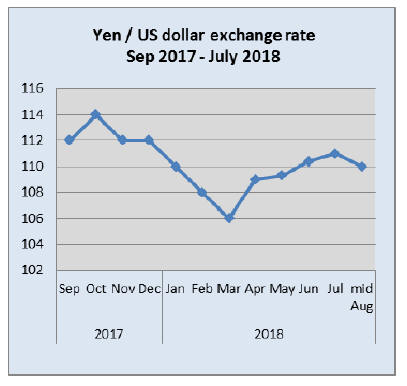
July rise in housing starts disguises
overall trend
July marked the third straight increase in housing starts but
this disguises the fact that, year on year, July starts were
down almost 1%. The decline in year on year July starts
was slower than forecast, analysts had expected a 4%
drop.
In addition to the housing starts numbers the Ministry of
Land, Infrastructure, Transport and Tourism also provides
data in its survey on orders received by construction
companies. The 50 biggest contractors reported a 9%
decline in orders during July.
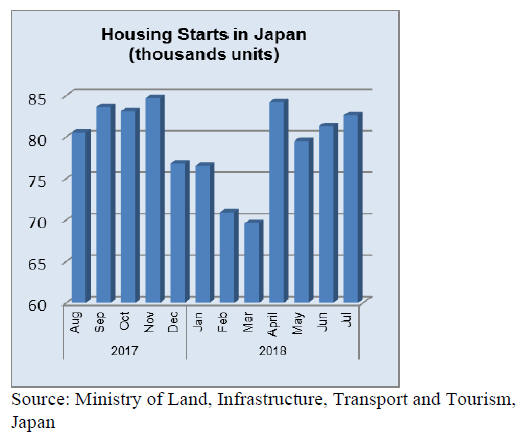
Much of the discussion recently on the housing
market has
focused on zero-energy apartments as housing developers
begin to introduce advanced building concepts, common
in detached homes, into this new area.
The concept of a zero-energy home is one where the home
is energy neutral through the use of solar panels and other
renewable sources.
The government is promoting this concept and aims to
have 50% of new homes to be zero-energy by 2020.
According to recent research, households accounted for
16% of Japan's carbon emissions in fiscal 2016 so cutting
back on emissions from homes could play a big part in
Japan¡¯s target under the 2015 Paris Agreement on climate
change.
Import round up
Doors
June door imports
The value of Japan¡¯s first half 2018 imports of wooden
doors HS441820 was unchanged compared to the same
period in 2017 despite the March and April 2018 dip in
imports, a characteristic trend at the end of each financial
year in Japan.
After the peak in May imports, the value of wooden door
imports was down 7% in June with some 63% being
supplied from China and another 20% being shipped from
suppliers in the Philippines.
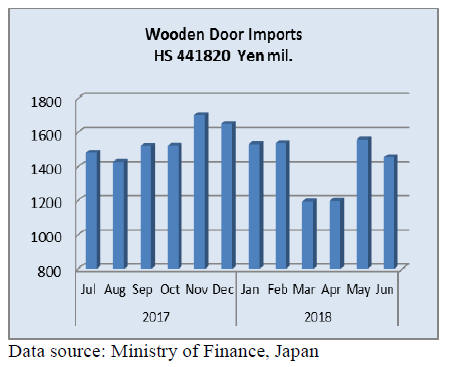
Window imports
June window imports
The value of Japan¡¯s imports of wooden windows
(HS441810) has remained fairly constant in the first six
months of 2018. The only month where there was a
change was in March when a slight rise was recorded.
However, compared to the value of imports in the first half
of 2017 there was an 8% decline seen in the first half of
2018.
The value of Japan¡¯s June wooden window imports were
unchanged year on year as well as compared to levels in
May.Wooden windows coming into Japan originate in
China (38%), the Philippines (31%) and the US (19%).
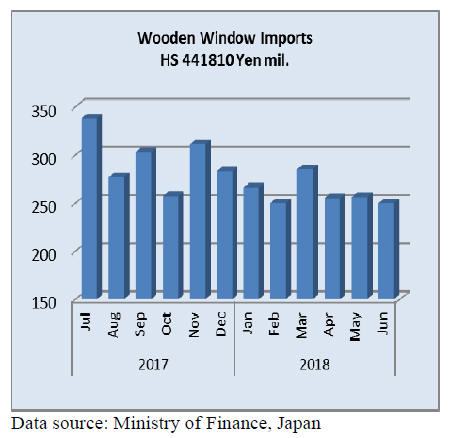
Assembled flooring
June imports
Japan¡¯s imports of wooden flooring continue to be
dominated by HS441875 followed by HS441879.
Together these two categories of assembled flooring
accounted for around 90% of the value of all assembled
wooden flooring imports.
Despite the rollercoaster trend in the value of imports, the
value of first half 2018 imports was almost unchanged
from the same period in 2017. However, the value of June
2018 imports was down 17% year on year and compared
to a month earlier June imports dropped 23%.
June shipments of HS441875 were dominated by China
(50%) and Indonesia (21%) with most of the balance made
up of shipments from Thailand and Malaysia.
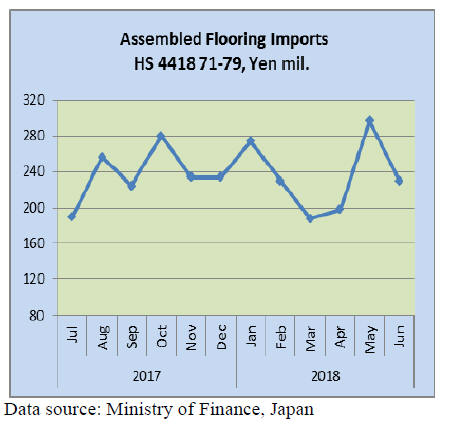
Plywood
June plywood imports
There was a sharp decline in Japan¡¯s imports of Malaysian
plywood in June 2018. The average volume of imports
from Malaysia between January and May 2018 was
around 90,000 cu.m but June imports dipped to just over
77,000.
Production in Malaysia has been falling as the State
government is strictly enforcing felling limits. June 2018
marked the first month in recent years when the volume of
plywood imports from Indonesia exceeded those from
Malaysia.
Year on year the volume of June 2018 imports of plywood
(HS 441210-39) were up 14% but month on month,
largely due to lower shipments from Malaysia, imports fell
12%.
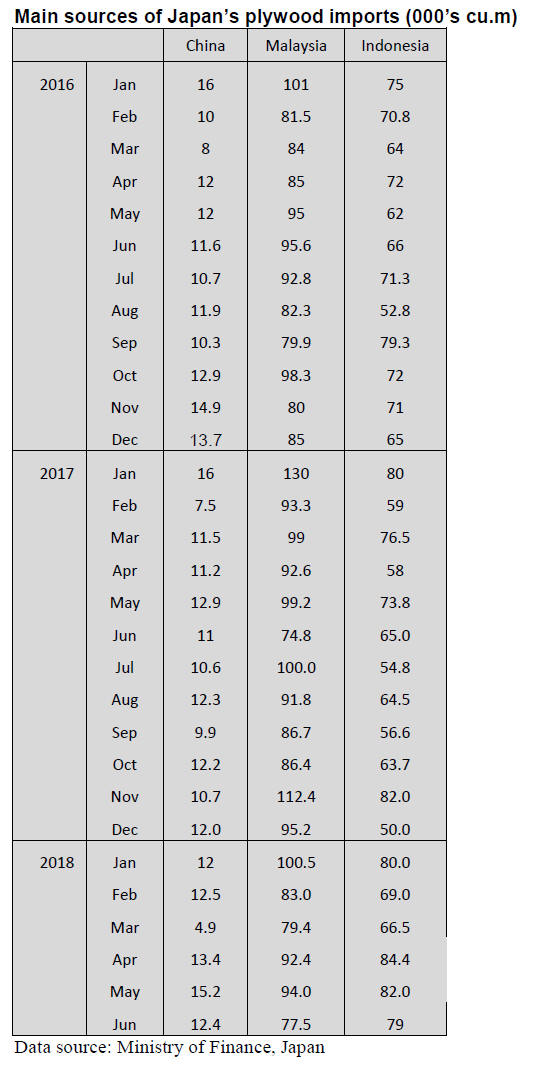
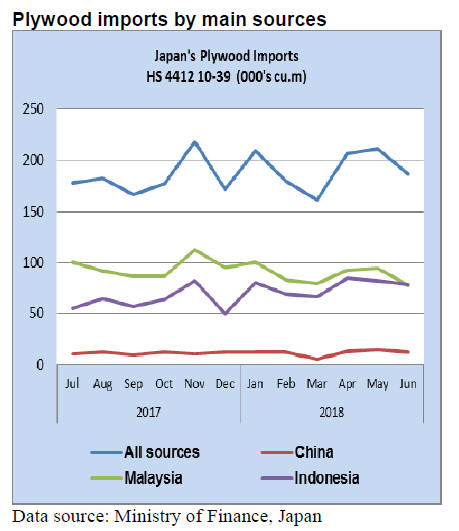
Trade news from the Japan Lumber Reports (JLR)
For the JLR report please see:
http://www.nmokuzai.
com/modules/general/index.php?id=7
Climbing demand of wood pellets
Demand of wood pellet is sharply increasing. Import of
wood pellet is about six times of 2013 and domestic
demand is 9% more than 2013. Reason is starts-up of large
biomass power generation facilities, which use wood
pellet solely to combines with other fuel like coal.
Import of wood pellet in 2017 is about 510,000 ton, 46%
more than 2016 while domestic production was about
120,000 ton, 0.5% more.
In 2013, total supply of wood pellet was about 190,000 ton
in which share of import was 43% then since 2015 supply
by import surpassed domestic supply then in 2017, share
of import rose to about 80%.
Meantime, the domestic supply will increase considerably
as the largest manufacturer, Meiken Lamwood (Okayama
prefecture) plans to produce about 30,000 ton a year and
Toono Kousan (Fukushima prefecture) is testing a new
plant, which will produce about 30,000 ton a year. Then
Sumitomo Forestry plans to build a new wood pellet plant
jointly with electric power company.
Increase of import of wood pellet will skyrocket after 2020
since demand of biomass fuel will expand sharply. There
are many projects of biomass power generation plant on
the coast lined-up. There are two plants with power output
of 75,000 kw in Fukuoka prefecture. Both will start up in
2021.
One in Ibaraki prefecture with output of 51,500 kw and
another in Chiba with output of 75,000 kw are planned,
which will start operating in 2021 and 2022. They are all
counting imported wood pellet as fuel. Also large electric
power companies are counting to use wood pellet in large
volume after 2022.
With expansion of imported wood pellet, trading firms are
actively engaged in securing overseas sources. Sumitomo
Forestry, which handled about a half of all the imported
wood pellet in 2017, will increase the volume to350,000
ton in 2018 after test run of tie-up power generation plant
starts this year.
Itochu Corporation will handle about 200,000 ton with
sales contract with a large power generation company.
Trading companies are busy looking for overseas source
of wood pellet and try to make long term supply contract
with the suppliers.
In related news, the domestic Asahi newspaper of 31
August has a story on illegal logging of cedar in Japan.
Prices for cedar logs have risen sharply over the past year
on the back of demand in export markets such as China,
the Philippines and South Korea. Prices have also been
given a boost from demand in the domestic consumption
in bio-fuel sector. According to the Asahi newspaper there
are growing reports of theft of trees in Kyushu and in
Okinawa.
Plywood
The softwood plywood market is weakening but there is
no price collapse. In distribution channels, there are some
low price offers with various rumors so the market is
confusing. June softwood plywood production in June was
271,900 cbms, 2.4% more than June last year and 8.0%
more than May.
This is the highest monthly production. The shipment in
June was 249,700 cbms, 5.1% less and 3.8% more. The
inventory is 163,400 cbms, which is far less than one
month consumption.
The manufacturers think this is no excessive level
inventory and if the consumption picks up, it would drop
in no time. Imported plywood market does not show any
improvement. Some indicate recovery of movement but
once tight supplied coated concrete forming panel is
readily available now and over supply is now feared so the
price increase is not progressing.
Malaysian and Indonesian suppliers are preparing higher
prices before rainy season with limited offers for Japan.
The importers feel future purchase is difficult with
remaining order balances so they buy minimum necessary
volume only.

Domestic softwood plywood market
Market of softwood plywood is weak. There are some low
price offers in the market but they do not help move more
volume. Actually there are various prices in the market
and it is hard to pin point median prices. In confusing
market, wholesalers are taking cautious approach and
wait-and-see attitude is prevailing.
Softwood plywood manufacturers are holding the prices
without any price reduction. Softwood plywood
inventories at the end of June were 163,400 cbms, 22,300
cbms more than end of May. The inventories have been
increasing for five straight months but based on monthly
shipment volume, they are only 0.6 month so they are not
excessive inventories.
Orders for precutting plants are improving some from June
but there are differences among companies and areas so
upward momentum is not there yet. Also there is prospect
that demand for restoration of floor damaged areas in the
Western Japan should show up but so far there is none yet.
After all, there is very little factor to push the market up
but as long as the manufacturers maintain the prices, it is
hard for wholesalers to continue price reduction.
Therefore, the key is if the manufacturers can hang on
present sales prices.
South Sea (tropical) logs
South Sea log import for the first half of this year was over
80,000 cbms, 30% higher than 2017. Log FOB prices
temporarily softened in last fall and procured logs at this
time arrived all at once early this year. Logs from Sabah
were30% more and logs from PNG doubled.
With log export ban by Sabah, future log arrivals would
drop sharply. There is no logs in distribution channels in
Japan so market prices are unchanged.
|